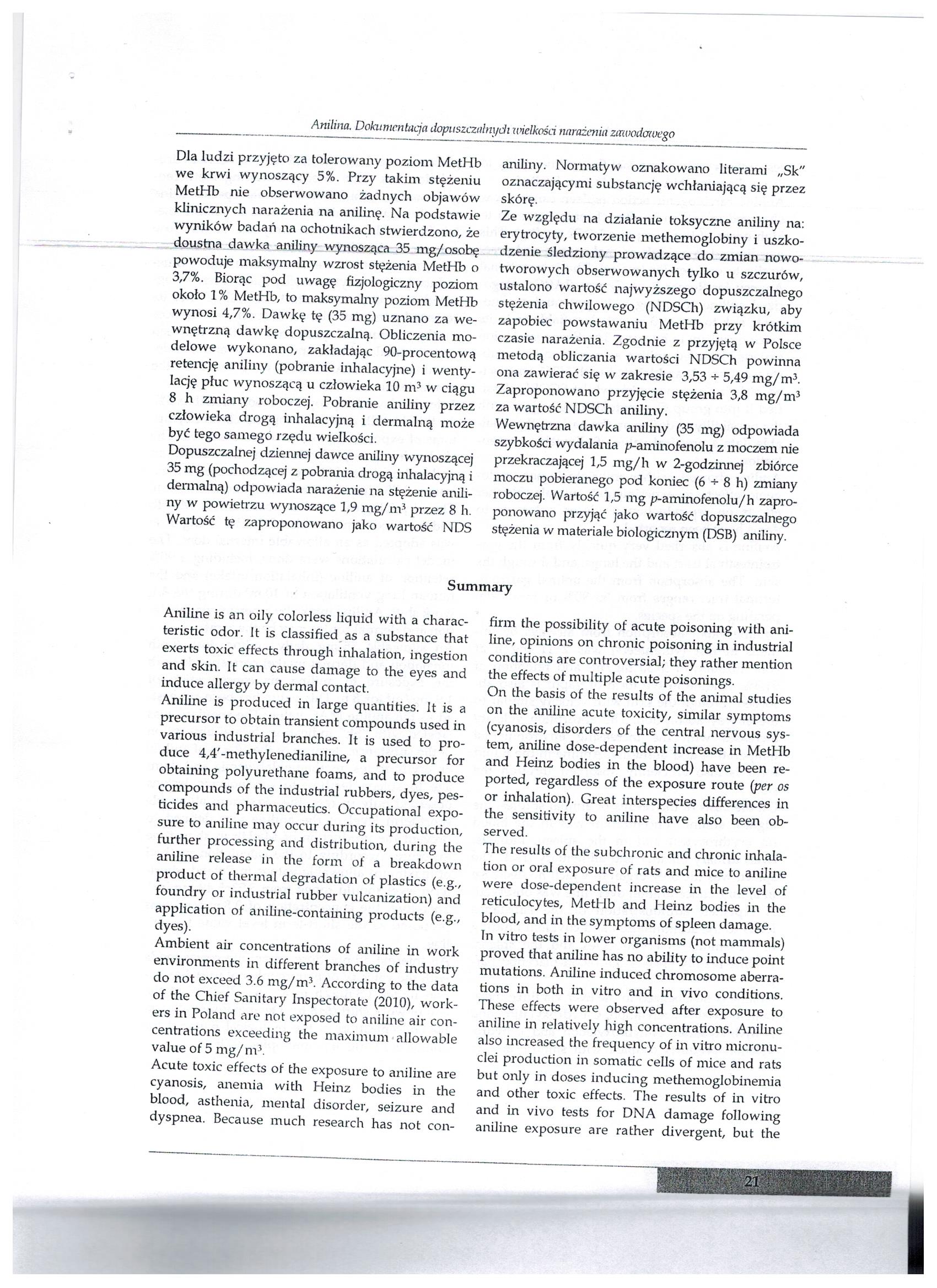Obraz (80

Anilina. Dokumentacja dopuszczalnych wielkości narażenia zawodowego
Dla ludzi przyjęto za tolerowany poziom MetHb we krwi wynoszący 5%. Przy takim stężeniu MetHb nie obserwowano żadnych objawów klinicznych narażenia na anilinę. Na podstawie wyników badań na ochotnikach stwierdzono, że doustna dawka aniliny wynosząca 35 mg/osobę powoduje maksymalny wzrost stężenia MetHb o 3,7%. Biorąc pod uwagę fizjologiczny poziom około 1% MetHb, to maksymalny poziom MetHb wynosi 4,7%. Dawkę tę (35 mg) uznano za wewnętrzną dawkę dopuszczalną. Obliczenia modelowe wykonano, zakładając 90-procentową retencję aniliny (pobranie inhalacyjne) i wentylację płuc wynoszącą u człowieka 10 m3 w ciągu 8 h zmiany roboczej. Pobranie aniliny przez człowieka drogą inhalacyjną i dermalną może być tego samego rzędu wielkości.
Dopuszczalnej dziennej dawce aniliny wynoszącej 35 mg (pochodzącej z pobrania drogą inhalacyjną i dermalną) odpowiada narażenie na stężenie aniliny w powietrzu wynoszące 1,9 mg/m3 przez 8 h. Wartość tę zaproponowano jako wartość NDS aniliny. Normatyw oznakowano literami „Sk" oznaczającymi substancję wchłaniającą się przez skórę.
Ze względu na działanie toksyczne aniliny na: erytrocyty, tworzenie methemoglobiny i uszkodzenie śledziony prowadzące do zmian nowotworowych obserwowanych tylko u szczurów, ustalono wartość najwyższego dopuszczalnego stężenia chwilowego (NDSCh) związku, aby zapobiec powstawaniu MetHb przy krótkim czasie narażenia. Zgodnie z przyjętą w Polsce metodą obliczania wartości NDSCh powinna ona zawierać się w zakresie 3,53 + 5,49 mg/m3. Zaproponowano przyjęcie stężenia 3,8 mg/m3 za wartość NDSCh aniliny.
Wewnętrzna dawka aniliny (35 mg) odpowiada szybkości wydalania /^-aminofenolu z moczem nie przekraczającej 1,5 mg/h w 2-godzinnej zbiórce moczu pobieranego pod koniec (6 + 8 h) zmiany roboczej. Wartość 1,5 mg /^aminofenolu/h zaproponowano przyjąć jako wartość dopuszczalnego stężenia w materiale biologicznym (DSB) aniliny.
Sum mary
Anilinę is an oily colorless licjuid with a charac-teristic odor. It is classified as a substance that exerts toxic effects through inhalation, ingestion and skin. It can cause damage to the eyes and induce allergy by dermal contact.
Anilinę is produced in large quantities. It is a precursor to obtain transient compounds used in various industrial branches. It is used to pro-duce 4,4'-methylenedianiline, a precursor for obtaining polyurethane foams, and to produce compounds of the industrial rubbers, dyes, pes-ticides and pharmaceutics. Occupational expo-sure to anilinę may occur during its production, further processing and distribution, during the anilinę release in the form of a breakdown product of thermal degradation of plastics (e.g., foundry or industrial rubber vulcanization) and application of aniline-containing products (e.g., dyes).
Ambient air concentrations of anilinę in work environments in different branches of industry do not exceed 3.6 mg/m3. According to the data of the Chief Sanitary Inspectorate (2010), work-ers in Poland are not exposed to anilinę air concentrations exceeding the maximum allowable value of 5 mg/m3.
Acute toxic effects of the exposure to anilinę are cyanosis, anemia with Heinz bodies in the blood, asthenia, mental disorder, seizure and dyspnea. Because much research has not con-firm the possibility of acute poisoning with anilinę, opinions on chronic poisoning in industrial conditions are controversial; they rather mention the effects of multiple acute poisonings.
On the basis of the results of the animal studies on the anilinę acute toxicity, similar symptoms (cyanosis, disorders of the central nervous system, anilinę dose-dependent inerease in MetHb and Heinz bodies in the blood) have been re-ported, regardless of the exposure route {per os or inhalation). Great interspecies differences in the sensitivity to anilinę have also been ob-served.
The results of the subchronic and chronic inhalation or orał exposure of rats and mice to anilinę were dose-dependent inerease in the level of reticulocytes, MetHb and Heinz bodies in the blood, and in the symptoms of spleen damage.
In vitro tests in Iower organisms (not mammals) proved that anilinę has no ability to induce point mutations. Anilinę induced chromosome aberra-tions in both in vitro and in vivo conditions. These effects were observed after exposure to anilinę in relatively high concentrations. Anilinę also inereased the frequency of in vitro micronu-clei production in somatic cells of mice and rats but only in doses inducing methemoglobinemia and other toxic effects. The results of in vitro and in vivo tests for DNA damage foliowing anilinę exposure are rather divergent, but the
Wyszukiwarka
Podobne podstrony:
Obraz (65 Anilina. Dokumentacja dopuszczalnych wielkości narażenia zawodowego samce, 15 w grupie Kha
Obraz (69 Anilina. Dokumentacja dopuszczalnych wielkości narażenia zawodowegoDziałanie uczulające Uc
Obraz (74 Anilina. Dokumentacja dopuszczalnych wielkości narażenia zawodowego wahały się w granicach
Obraz (87 Anilina. Dokumentacja dopuszczalnych wielkości narażenia zawodowegoZALEŻNOŚĆ SKUTKU TOKSYC
Obraz (89 Anilina. Dokumentacja dopuszczalnych wielkości narażenia zawodowego uznano, że w praktyce
Obraz (61 Anilina. Dokumentacja dopuszczalnych wielkości narażenia zawodowego cd. tab. 11. ; Os4-p
Obraz (67 Anilina. Dokumentacja dopuszczalnych wielkości narażenia zawodowego Gamick zwierząt,&nbs
Obraz (81 Anilina. Dokumentacja dopuszczalnych wielkości narażenia zawodowego % *47i A ”. rlittfc
Obraz (93 Anilina. Dokumentacja dopuszczalnych wielkości narażenia zawodowegoZAKRES BADAŃ WSTĘPNYCH
Obraz (63 Anilina. Dokumentacja dopuszczalnych wielkości narażenia zmwdowego Testy wykonywane w waru
Obraz (76 Anilina. Dokumentacja dopuszczalnych wielkości narażenia zawoderwego (ESIS online). W 1998
Obraz (78 Anilina. Dokumentacja dopuszczalnych wielkości narażenia zawodenuegoCHARAKTERYSTYKA SUBSTA
Obraz (83 Anilina. Dokumentacja dopuszczalnych nńelkości narażenia zawodowego istotny statystycznie
Obraz (91 Anilina. Dokumentacja dopuszczalnych nńelkości narażenia zawodowego wchłanianie 72 mg anil
więcej podobnych podstron